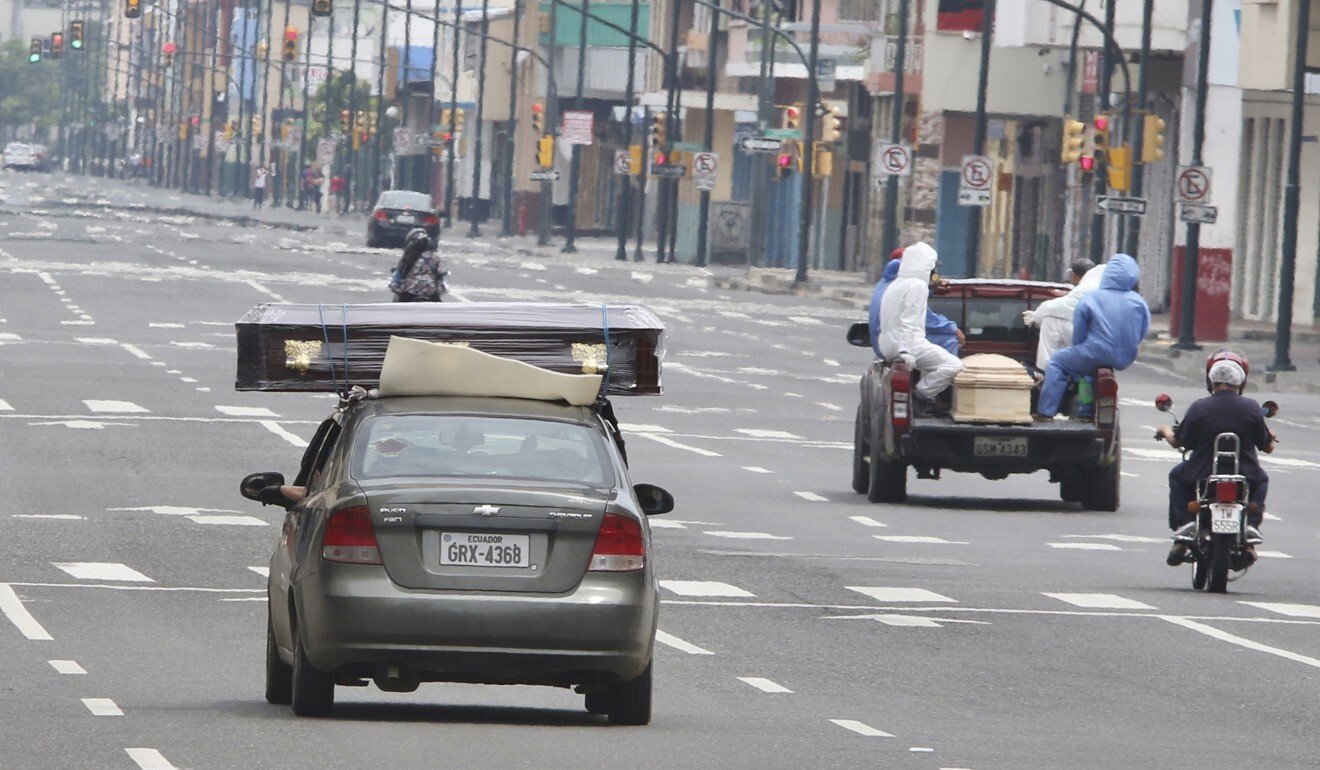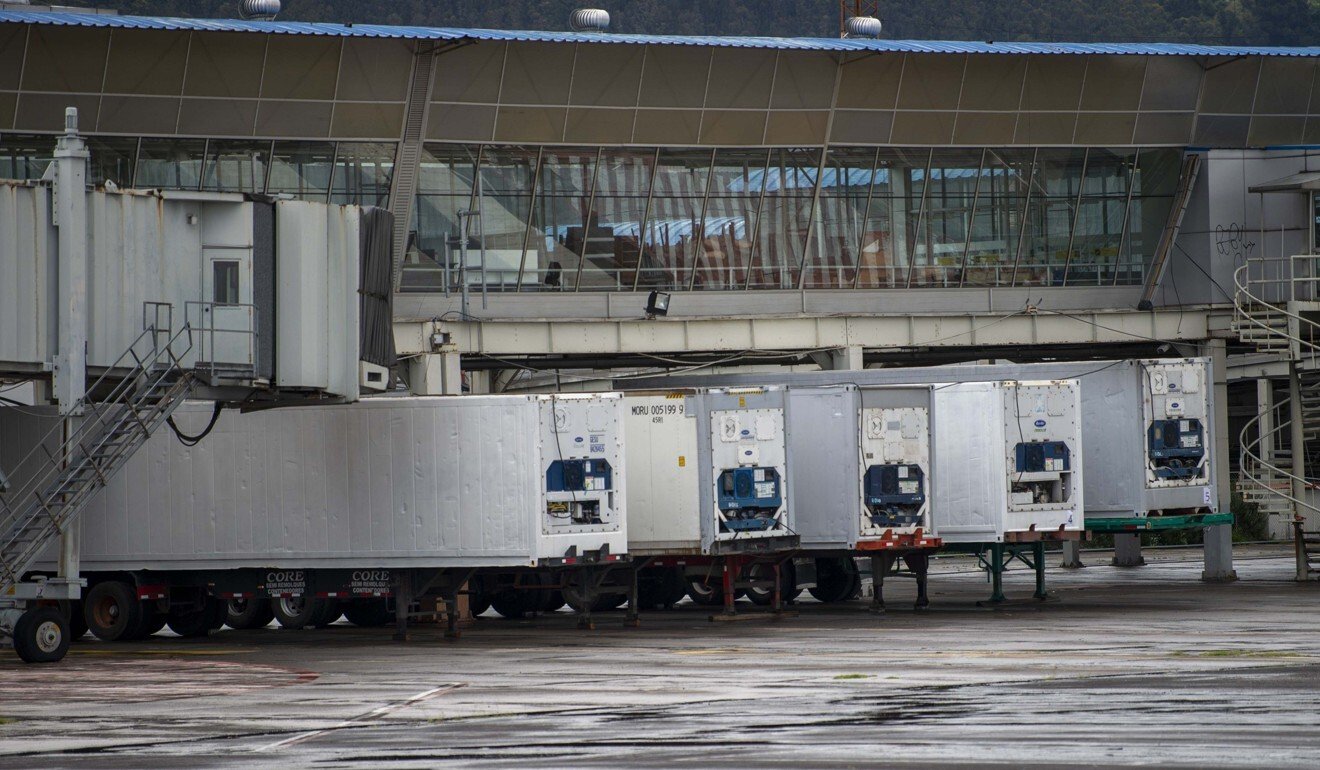Ecuador’s coronavirus horror: bodies ‘stacked seven high’ in bathrooms as morgues fill up
- Medical staff describe grisly scenes in city some refer to the ‘Latin American Wuhan’
- The pandemic has hit Ecuador with disproportionate force

Front line doctors in one of Latin America’s coronavirus epicentres are lifting the lid on the daily horrors they face in an Ecuadorean city whose health system has collapsed.
In one hospital in Guayaquil overwhelmed by Covid-19 patients, staff have had to pile up bodies in bathrooms because the morgues are full, health workers say.
In another, a medic said that doctors have been forced to wrap up and store corpses to be able to reuse the beds they died on.
Ecuador has recorded close to 23,000 coronavirus cases and nearly 600 deaths, with Guayaquil – which some refer to as “Latin America’s Wuhan” (mainland China’s epicentre) – by far its worst affected city. But the real toll is thought to be far higher.
The shocking images of bodies left on the streets that went viral in March and April proved a warning about the virus’ capacity to collapse fragile health care and mortuary systems, especially in developing nations.
A 35-year-old nurse at the first hospital who spoke on condition of anonymity said that the trauma of what he saw had affected him professionally and personally.
When the health emergency broke out in March, every nurse went from caring for 15 patients to 30 in the space of just 24 hours, he added.
“So many people arrived that … they were practically dying in our hands,” said the nurse.
Patients were discharged or referred to other facilities “to free up all these beds” for coronavirus patients, he said.
“They took out anaesthesia machines from operating rooms to replace them with ventilators.
“People are alone, sad, the treatment wreaks havoc on the gastrointestinal tract, some defecate; they feel bad and think they will always feel that way, and they see that the person next to them starts to suffocate and scream that they need oxygen.”
It isn’t just hospitals that have been overwhelmed, but morgues too.
“The morgue staff wouldn’t take any more, so many times we had to wrap up bodies and store them in the bathrooms,” the nurse said.

Only when the bodies were “stacked up six or seven high did they come to collect them.”
A 26-year-old colleague, also a nurse, confirmed the chaotic scenes.
“There were many dead in the bathrooms, many lying on the floors, many dead in armchairs,” she said
Guayaquil’s health system has collapsed under the pressure of the coronavirus, and it seems to be having catastrophic knock-on effects.
In the first half of April, the province of Guayas, whose capital is Guayaquil, recorded 6,700 deaths, more than three times the monthly average.
The disparity suggests that the real Covid-19 death toll is far greater than the official nationwide tally of fewer than 600.
President Lenin Moreno has acknowledged that Ecuador’s official coronavirus tallies “are short” of the true figures.
A 28-year-old doctor at a second Guayaquil hospital, who also insisted on anonymity, conjured a similarly grim picture of health services in crisis.
“Bodies were in the corridors of the emergency ward because the morgue was full,” the medic said, describing “20 to 25 corpses” waiting to be taken away.
“It was up to us to collect and wrap the corpse and store it so we could disinfect the bed for the next patient,” he added.

At the first hospital, refrigerated containers were brought in to store bodies, some of which remained for up to 10 days.
Some family members “break the covers … so the fluids come out. It’s a sanitary disaster,” said the 35-year-old male nurse.
The number of daily deaths fell last week but that was scant consolation for this nurse, who says he is tormented by what he has experienced.
When he goes home, after a 24-hour shift, his feet hurting, he tries to rest but then the “nightmare” strikes.
The pandemic has hit Ecuador with disproportionate force.
A country of 17.6 million, Ecuador is the 8th most populous nation in Latin America. Yet it stands second only to Brazil in the number of infections and Covid-19 deaths in Latin America.
Almost 70 per cent of Ecuador’s cases are from coastal Guayas province, which includes Guayaquil. And a local estimate of the coronavirus death toll during March and April, based on the usual amount of deaths, shows virus-related fatalities have already topped 7,000 in Guayaquil alone.
“The numbers are way higher than what the government wants to recognise,” said Juan Jose Illingworth, an Ecuadorean mathematician and newspaper columnist who has examined cemetery data to calculate how many more people are dying than usually would have.

By Illingworth’s analysis, Guayaquil suffered 6,948 likely coronavirus-related deaths between March 21 and April 22, or more than 217 a day.
In normal, non-pandemic circumstances, Illingworth said, 38 people would be expected to die each day in Guayaquil.
The peak of the crisis, Illingworth said, was April 6, when likely virus-related deaths soared to 460, further taxing already overwhelmed hospitals, morgues and funeral homes.
The city, Illingworth surmised, has “sustained the equivalent of 10 earthquakes”.
An earthquake in 2016 killed about 670 people throughout Ecuador.
Tropical Guayaquil’s extreme heat and humidity – the city sits at sea level about 245km (152 miles) south of the equator – clearly did not foil the contagion. That would seem to undermine assertions by US President Donald Trump and others that the onset of warmer weather in the Northern Hemisphere may slow the rate of infections.
A combination of factors likely contributed to the immense toll in Guayaquil, a bustling port city filled with open markets and an animated street life.
Additional reporting by Tribune News Service